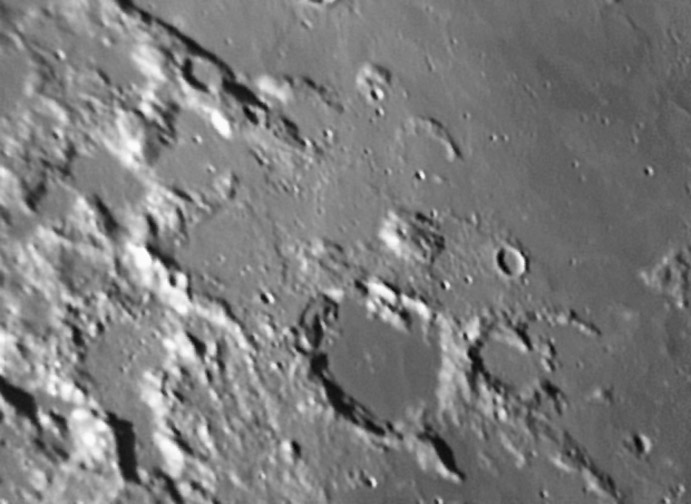|
|
| (2 intermediate revisions by the same user not shown) |
| Line 1: |
Line 1: |
| | __NOTOC__ | | __NOTOC__ |
| | =A Mountain or a Molehill?= | | =A Mountain or a Molehill?= |
| | + | <!-- Start of content --> |
| | <div class="post" id="post-495"> | | <div class="post" id="post-495"> |
| | | | |
| Line 6: |
Line 7: |
| | <p>[[File:Mt Maraldi-.jpg|Mt Maraldi-.jpg]]<br /> | | <p>[[File:Mt Maraldi-.jpg|Mt Maraldi-.jpg]]<br /> |
| | <em>image by <a>KC Pau</a></em></p> | | <em>image by <a>KC Pau</a></em></p> |
| − | <p>What is the real nature of a landform on the Moon? Recently, LPOD showed two high resolution Apollo 17 Metric Camera [http://www.lpod.org/?m=20060624 images] of a peculiar hill, Mount Maraldi, in Sinus Amoris. Now, K.C. Pau has captured a telescopic view that offers a different impression. On the Metric images Mons Maraldi appears as a flat-topped, relatively steep-sided, roughly circular peak. KC’s image, with opposite illumination, shows a less unique hill with more gentle slopes and a fresh-looking crater that is hardly there in the Apollo images. The crater is so conspicuous in the telescopic view that I wondered if it had formed since Apollo times! But looking carefully at the right image of the Metric pair I could recognize the crater, although it was less obvious. In the Metric view Mons Maraldi looks strange, and I speculated in the earlier LPOD that it was probably a volcanic dome of a type of volcanic rock not sampled by Apollo astronauts. Looking at today’s image alone I would probably dismiss the mons as an isolated piece of highlands of no particular interest. So which is it?</p> | + | <p>What is the real nature of a landform on the Moon? Recently, LPOD showed two high resolution Apollo 17 Metric Camera [[June_24,_2006|images]] of a peculiar hill, Mount Maraldi, in Sinus Amoris. Now, K.C. Pau has captured a telescopic view that offers a different impression. On the Metric images Mons Maraldi appears as a flat-topped, relatively steep-sided, roughly circular peak. KC’s image, with opposite illumination, shows a less unique hill with more gentle slopes and a fresh-looking crater that is hardly there in the Apollo images. The crater is so conspicuous in the telescopic view that I wondered if it had formed since Apollo times! But looking carefully at the right image of the Metric pair I could recognize the crater, although it was less obvious. In the Metric view Mons Maraldi looks strange, and I speculated in the earlier LPOD that it was probably a volcanic dome of a type of volcanic rock not sampled by Apollo astronauts. Looking at today’s image alone I would probably dismiss the mons as an isolated piece of highlands of no particular interest. So which is it?</p> |
| | <p>[mailto:tychocrater@yahoo.com Chuck Wood]</p> | | <p>[mailto:tychocrater@yahoo.com Chuck Wood]</p> |
| | <p><strong>Technical Details:</strong><br /> | | <p><strong>Technical Details:</strong><br /> |
| Line 15: |
Line 16: |
| | <p><b>Tomorrow's LPOD:</b> [[August 17, 2006|Better Than Orbiter]] </p> | | <p><b>Tomorrow's LPOD:</b> [[August 17, 2006|Better Than Orbiter]] </p> |
| | </div> | | </div> |
| − | ----
| + | <!-- End of content --> |
| − | ===COMMENTS?===
| + | {{wiki/ArticleFooter}} |
| − | Register, and click on the <b>Discussion</b> tab at the top of the page.
| |
| − | <hr>
| |
| − | <!-- | |
| − | You can support LPOD when you buy any book from Amazon thru [[Support_ LPOD|LPOD]]!
| |
| − | -->
| |
| − | <span style="font-size:88%">
| |
| − | <center>
| |
| − | Contributions to http://www2.lpod.org/ are licensed under a Creative Commons Attribution No-Derivative-Works Non-Commercial 3.0 License. [http://www.creativecommons.org/licenses/by-nc-nd/3.0 http://www.wikispaces.com/i/creativecommons/by-nc-nd_3.0_80x15.png]<br>
| |
| − | </center>
| |
| − | </span>
| |




